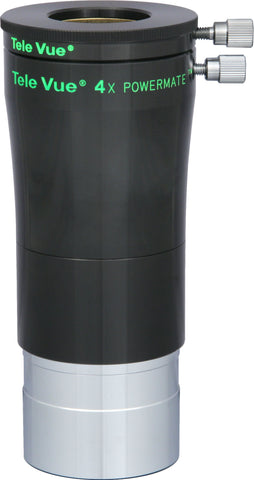Yes, our inventory is accurate!
![]() Qualifies for Free Ground Economy Shipping (CONUS Only)
Qualifies for Free Ground Economy Shipping (CONUS Only)
Description
To understand the Powermate™, we must first understand the Barlow lens. Barlows amplify the power of a telescope. They can be considered "focal reducers" for eyepieces, or "focal extenders" for objectives. Terence Dickenson, in his Barlow test report in Sky and Telescope, July 1997, says: "Technology has erased the old objections. A modern Barlow will not degrade your telescope's optics. Anyone telling you otherwise is using outdated information. Moreover, the highly regarded Nagler eyepieces and their clones have built-in Barlows, ample evidence that the lens is not some detrimental intruder." Thanks, Terence, for laying the myth of the degrading Barlow to rest.
A high quality Barlow must be properly designed and manufactured in order to avoid compromising a telescope's color and spherical aberration corrections. The "invisibility" of Tele Vue's 2-element Barlows has been noted in test reports in the astronomy magazines. However, by the nature of its negative power lens, a Barlow will do more than just increase magnification, regardless of the number of elements.
The diverging rays leaving the Barlow result in moving the exit pupil further out, thereby extending the eye relief. In short to medium focal length eyepieces the change is not noticeable. However, in the case of long focal length eyepieces, the increase can be significant and not without performance consequences.
Vignetting can occur due to the altered ray path, when the eyepiece's lenses are not large enough in diameter to allow all the rays to make it through. Shorter Barlows, or ones with too much magnification, only exacerbate the problem because the ray path entering the eyepiece is steeper.
We had to go beyond the Barlow concept to achieve the goal of a compact, high power, fully corrected image amplifier. The Powermate™ consists of a negative doublet plus a positive "pupil-correcting" doublet. This 4-element system provides the magnifying function of a Barlow without its limitations by restoring the field rays back to their original direction, as if the Powermate™ were not there. The result is a pure magnification increase.
- Vignetting, edge field aberrations and pupil movement - all introduced when using Barlows with long focal length eyepieces, are minimized.
- Telecentric operation (field rays leave parallel to optical axis, unlike Barlow lenses which diverge rays). This is ideal for Hydrogen-alpha filter use such as with Daystar models.
- High performance for image amplification, CCD or film (some of the finest Earth-based planetary imaging is being done with Powermates™ — see below).
- Flexible for visual and imaging with all types of telescopes and eyepieces. Essentially Parfocal, and with nearly constant magnification regardless of image distance behind top surface (except 5x model which increases 1x for every 35mm of image distance increase).
- Higher magnifications are possible with high optical performance compared to "doubling up" Barlows.
- All will reach parfocal point in star diagonals, except for the 2", 2x which comes very close.
In addition to full multi-coating, Powermates™ include other Tele Vue special touches such as safety undercuts where practical on the chrome barrel and captive lock screws that can't fall out, and filter threads. Our 100% QC program at f/4 insures that Powermates™ will add dramatic power (and NOTHING ELSE) to your favorite eyepieces.
If, for example, you own a 24mm Panoptic, you'll have the power of a 12mm focal length eyepiece with the 2.0x Powermate™, 9.6mm with the 2.5x Powermate™, a 6mm with the 4x Powermate™, or a 4.8mm with the 5x Powermate™!
Some of the finest Solar System images have been made with Powermates™. Used singly or stacked, Powermates™ help any scope achieve the long focal-length required to image details on Solar System bodies. The increased image scale allows for imaging without an intervening eyepiece -- like in prime focus photography. Powermate T-Ring Adapters fit on the Powermate lens assemblies to allow attachment of your camera's T-Ring or other T-threaded imaging accessory.
August 21, 2017 Solar Eclipse: Inside the SOLAR LAB (8/9/17). Read on our blog how Powermates™ interface with large solar telescopes, narrow-band filters, and exotic cameras to live-stream the Great American Eclipse of 2017.
These models stand less than 3" out of your focuser and the 5x takes 1¼" threaded filters. They are parfocal in ALL 1¼" diagonals and prisms. For this reason, they are highly recommended over standard Barlows for 1¼" diagonals and refractors such as the Tele Vue-60.
The 5x Powermate™ is ideal for long focus CCD and film photography, magnifying about 7.7x. It's an attractive, high performance alternative to eyepiece projection. The 5x is also perfect for slowing down your scope for Hydrogen-Alpha solar observing.
These Powermates™ are a better choice for 2" diagonals than Barlows, since they are nearly Parfocal. They are threaded for 48mm filters and their performance is excellent with every 1¼" and 2" eyepiece we make (yes, even the 31mm Nagler Type 5!). Both the 2" eyepiece holder and the special 2" flat top adapter use our brass clamp rings for secure operation. And, it also has a very unique feature: you can unscrew the 2" eyepiece housing and screw on a special T-ring adapter for solid, compact attachment of CCD or camera equipment.
Excellent with long eye-relief, 2" eyepieces. Using the 4x model, imagine the quality of a 35mm Panoptic at 8.8mm with 25mm of eye relief! The Powermate™ is NOT a Barlow so the Panoptic-Barlow Interface is not needed! The 2" Powermate™ fits all the way into 2" Star Diagonals, requiring minimal refocus compared to a 2" Barlow.
When using Tele Vue's Paracorr coma corrector, the 2.5x or 5x Powermate™ should be inserted into the Paracorr's 1¼" adapter (i.e., between the Paracorr and the eyepiece). For 2x and 4x 2" Powermates™, first insert the Powermate™ into the focuser, then the Paracorr into the Powermates™.
Specifications
Powermate (size/weight-lbs)
| 4x Powermates™ | 2" w/1¼" adapter / 1.20 |



